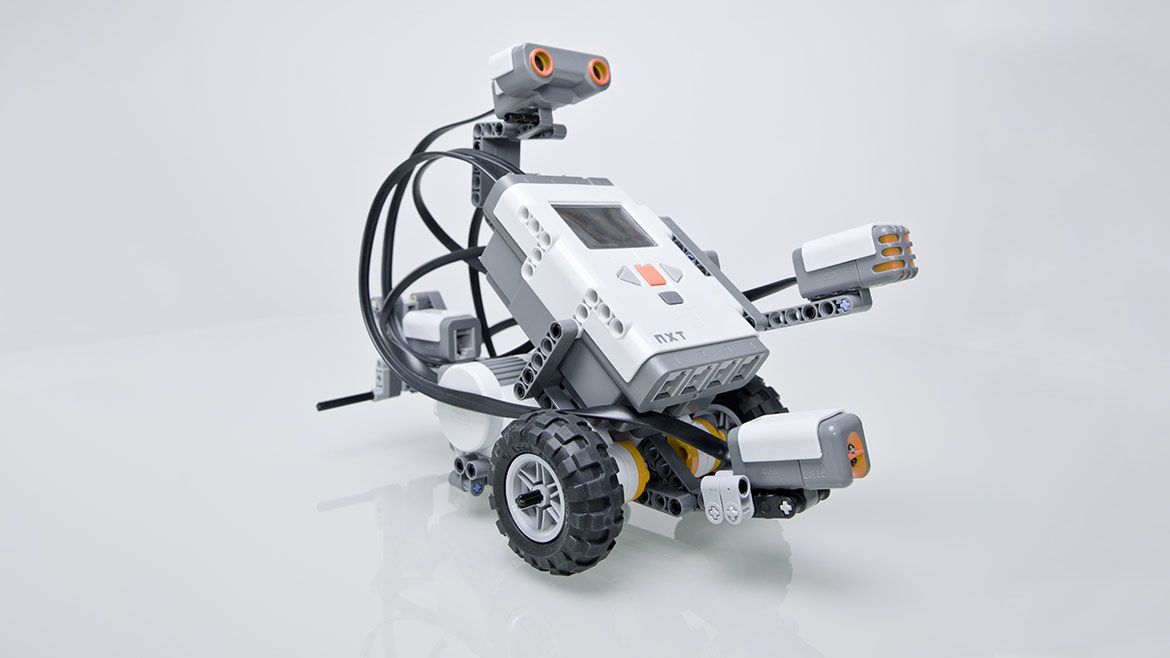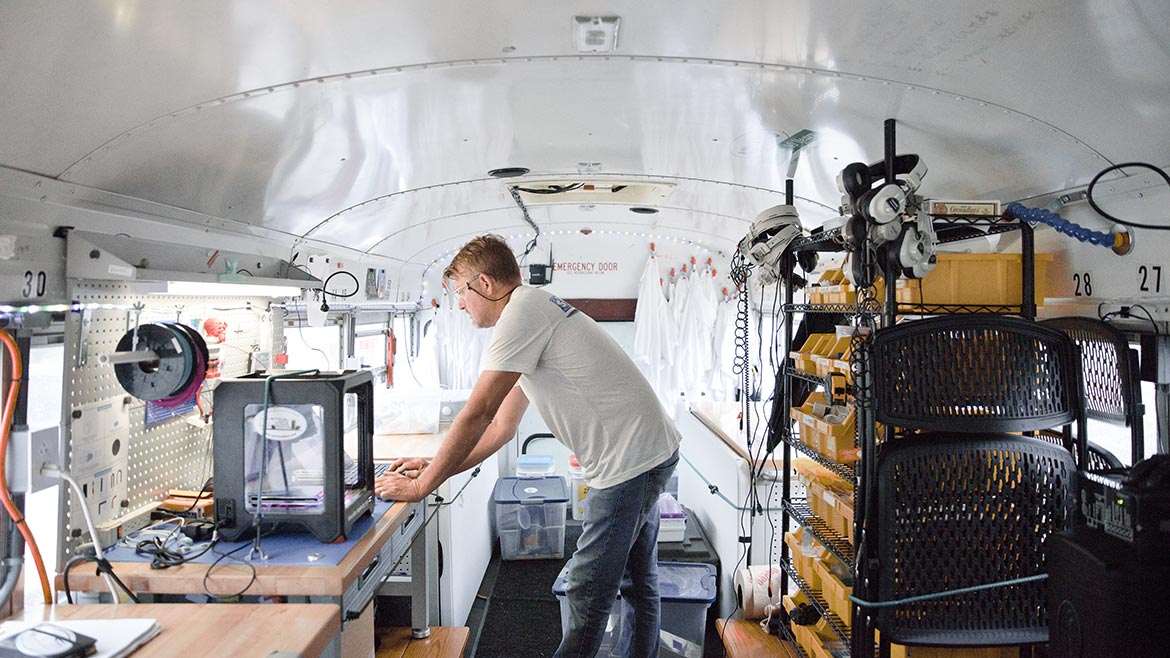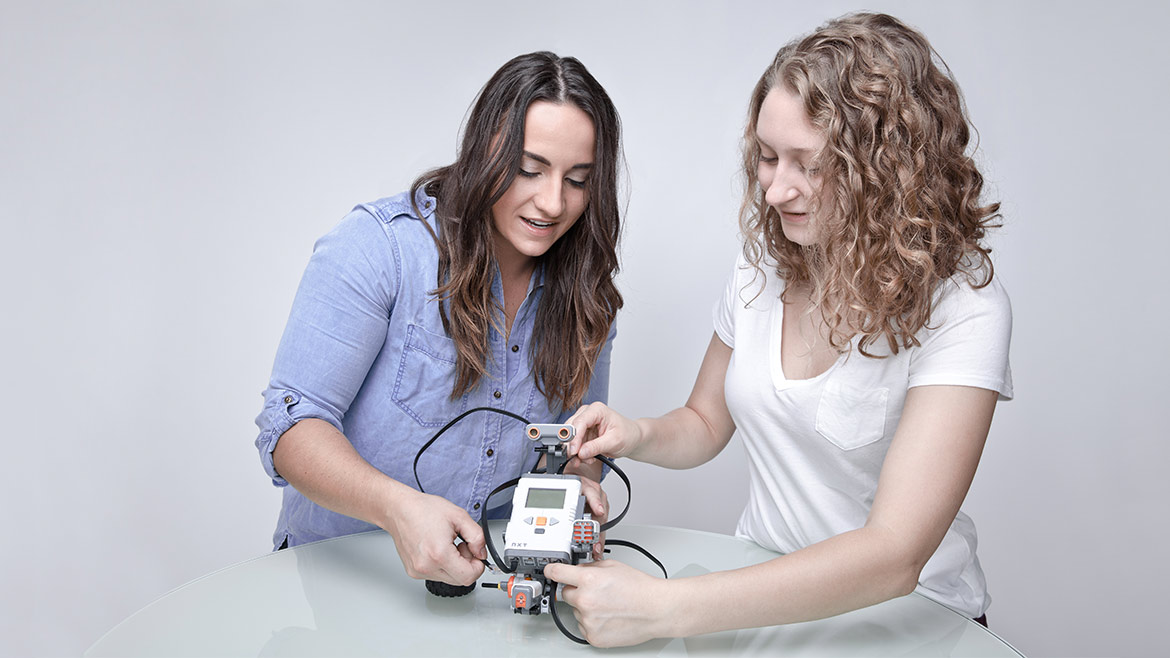How to Make an Innovator: STEM Education in Columbia
- photos by Anthony Jinson

Craig Adams, walking through the offices of Columbia Public Schools’ administration building on Worley Street, is mulling over an idea that his superintendent, Peter Stiepleman, just floated out to him. Adams sits down in a chair in Stiepleman’s office and takes his clear, thick-frame glasses off. He rubs the gray stubble on his chin.
Adams is the CPS STEAM (science, technology, engineering, arts, and math — CPS’s spin on the more conventional “STEM”) coordinator, and he’s spent this school year driving to different schools in the STEAM Bus, the school-bus-turned-laboratory that CPS created last year, and helping teachers design alternative classes to teach kids about science, math, and practical problem solving. The bus is packed with gear not otherwise available to students — robots, nanobots, a drone, a 3D printer, virtual reality headsets made from Shakespeare’s pizza boxes, etc. Stiepleman told Adams there’s been some talk about driving the bus out to the Perry Juvenile Justice Center, outside of Columbia. Adams is excited about it.
“I like those kids,” Adams says. “I like them. I would totally go for it. I’ve always liked working with bad kids — or, kids who thought they were bad. I can connect with them . . . that’s really where I came from. I wasn’t your typical good student. I wasn’t that person.”
Adams was a shop teacher for 24 years at Jefferson Middle School, where he still keeps his home base. He struggled in school, particularly in classes where he had to sit at a desk. After graduating, he wanted to be an architect, at first, but lost interest; then he wanted to be a mechanic, then a computer specialist. “That was horrible,” he says. “Too boring. But you put all those things together and what do you get?”
CPS’s plan to innovate STEM education depends on students who are like Adams was — kids with a latent passion for tinkering but little patience for traditional classroom settings. If Adams can successfully steer those kids toward high-demand career paths in STEM fields, then, hopefully, they can feed back into the school system as local STEM professionals. Ultimately, with enough success in the first five years, CPS wants to make Jefferson Middle the first STEAM-focused middle school, in the same way they’ve made Lee Elementary an expressive arts school.
Stiepleman describes the district’s approach as — “for lack of a better word,” he says — an infection model: the more teachers use Adams and non-traditional STEM education, the more other teachers will want to give it a try. It’s a plan predicated on having people believing it will work, and for that to happen, change has to happen outside the district as well.
Building Commitment
The United States is widely believed to be bad at STEM education. Various international groups rank the U.S.’s science and math education in the middle of the pack or lower among industrialized countries. In 2012, the Program for International Student Assessment ranked the U.S. 35th out of 64 countries in math education, and 27th in science. In another ranking, this one of 34 countries, the Organization for Economic Cooperation and Development ranked the U.S. 27th in math and 20th in science. And while there is positive data — graduate enrollments in STEM subjects, for instance, have gone up since 2007, particularly among minority groups — U.S. citizens take an even dimmer view of our STEM education than international rankings do: a 2015 Pew survey reported that 51 percent of respondents said that U.S. scientific achievements were at least above average, but only 29 percent said the same thing about K–12 STEM education.
And it’s not that the U.S. has been ignoring the problem. The country heavily focused on STEM education for decades, starting in the 1950s, and when the number of students declaring STEM majors sharply declined, in the early ’90s, the need for improved K–12 emphasis became a popular platform. Between 1987 and 2009, 200 bills were introduced in congress containing points about science education. The federal government appropriates somewhere between $2.8 billion and $3.4 billion for STEM education annually.

Meera Chandrasekhar, a physics professor at MU who grew up in India, first became interested in physics when everyone in the U.S. did — during the space race. “It was kind of really exciting because that was the smart thing, you know?” she says. “And I was hearing about all the launches and John Glenn going up and all of that stuff [she was 12 during Glenn’s orbit], so there were lots of interesting things going on, none of which made sense to me.”
Chandrasekhar’s father was a military officer in India, and their family moved around a lot, which gave Meera plenty of time to incubate her curiosity about physics without any interference from a classroom. By the time she finally took a proper physics class, in 10th grade, she had developed a reverence for science that carried her through her college classes in India and, later, her Ph.D work at Brown University.
Chandrasekhar moved to Columbia in 1981, when her husband, H.R. Chandrasekhar, also a physicist, was appointed to the MU faculty. Meera had enjoyed teaching as a graduate student-teacher at Brown, and she taught at MU in part-time capacities until 1989, when she also became a full professor. On a whim in the early ’90s — the same time U.S. students were slowing their enrollment in STEM fields — Meera teamed up with Becky Litherland, CPS’s science coordinator at the time, to develop a program to get female students interested in physics. The program eventually expanded to include other courses and other MU programs collaborating with CPS. Chandrasekhar continued working with younger students, balancing her own research and course load at MU. She received the Presidential Award for Mentoring in Science and Engineering in 1999.
“I don’t quite know what it is [about teaching,],” Chandrasekhar says. “It was interesting to me because I found this thing — the human aspect of it — very interesting. So it’s just taken on a life of its own. It’s never been boring. If it was boring, I’d quit doing it.”
Chandrasekhar’s latest project is A TIME for Physics First, a program funded by the National Science Foundation that helps teachers from 36 partner school districts in Missouri learn how to effectively teach a freshman physics class. The project ran from 2009 to 2014, and Chandrasekhar is still working to make the Physics First program more widely available.
Teachers in the project learned more Socratic ways of teaching physics based on conceptual, rather than quantitative, problem solving — “building a community around science,” Chandrasekhar says. Kids are encouraged to explore their own experiments and question what they’re seeing. Participation in the project required absolute commitment that the school districts involved would start teaching physics to ninth graders (most high schools start with biology, putting physics off until junior year). It was one of the ways to make the principles stick, to safeguard against a district sending teachers to the program without ever intending on changing the way they actually taught. Chandrasekhar says it takes “a lot of moral courage” for a teacher to change the way they do their job, particularly when it can mean losing control of a class.

“Teachers I’ve met who are really dedicated are just the people who believe [teaching] is the right thing to do,” she says. “And I don’t know if that’s always why they started, but somewhere down the line, they thought, ‘Gosh, I am making a difference in the life of kids who might just completely go astray if I did not have the handle on them.’”
That’s a problem CPS has to solve too: why should teachers have to change the way they teach? How do you prove to them that it works? Chandrasekhar is now working on developing an online curriculum based on the Physics First programs, and she has the data, in the Physics First project results report, to back up her credibility: 97 percent of teachers in the program say their physics knowledge increased, and 94 percent said the program helped their students learn more about physics.
The STEAM Program isn’t without metrics or long-term planning. The district has four established objectives in a (roughly) five-year plan: introduce STEAM to the students and teachers, teach students curricular concepts through the program, work with teachers on professional development in teaching STEM subjects, and establish the STEAM school at Jefferson Middle. Each objective has its own tracking methods, like standardized test comparison and survey analysis.
But Adams is a more freewheeling project lead than Chandrasekhar; Stiepleman’s nickname for Adams is “Willy Wonka.” His strength is action.
“We really are a good partnership in this,” Stiepleman says, “because I try to pull back and say, ‘Let’s have a plan in place, I need to check these things off,’ and he’s going, ‘Mhm, yeah, well I just got this partnership to do this, so we can go try it.’ It’s a push and pull.”
“And I do need that,” Adams says. “And this program needs that. . . . If there’s something to try, I want to try it, and if it doesn’t work, then we’ll keep going forward. But I need someone, every once in a while, to say, ‘OK, that’s not going to work.’”
The Long View
The STEAM program isn’t CPS’s first effort at shaking up STEM education. The CPS STEM Alliance, a program for connecting STEM business professionals with the district, already existed, and they’ve been working on incorporating free iPads into the classroom for every student to adapt to the tech-driven job market.
A common refrain in the STEM education crisis is that U.S. schools aren’t producing enough STEM professionals to fill the job market, with science and technology companies either hiring from overseas or not growing. Stiepleman says he hears this often from the Columbia business community — we need more local IT people, more engineers, more health scientists. The Columbia Area Career Center, a CPS affiliate, already offers students practical classes in STEM fields, often for college or certification credit, with a focus on filling the local job market. In Adams’ previous job, as CPS practical arts coordinator, he had a meeting with REDI and learned that 60 percent of CPS students end up staying and working in Columbia. “A lot of the stuff we’re doing on the bus is looking at what we need right here,” he says.
But most of the job-focused STEM programs CPS already has are focused on high schoolers — getting them college- or career-ready. Younger students, like most of the ones that Adams works with on the STEAM Bus, need more foundational knowledge to build on later.
CPS has frequently had elementary school students work with the MU College of Engineering’s LEGO robotics program, led by Professor Satish Nair, to sharpen their programming and engineering skills. The program runs camps for all ages in addition to their annual Robotics Design Challenge, where teams of students compete to build robots out of LEGOs and program them through a course, completing various objectives along the way. The LEGO program looks promising for STEM education because of what it teaches children — programming, design, communication, team problem solving — but also because of the program coordinators, Ben Latimer, Martha Gahl, and Dana Wegge. Latimer is a graduate of Missouri S&T doing post-graduate work at MU, and Gahl and Wegge are both undergraduates.

In 2007, according to data collected by the National Math and Science Initiative, about a third of public middle school science teachers either didn’t major in the subject in college or weren’t certified to teach it. Even for teachers who do have degrees in the subjects they teach, their day-to-day focus isn’t on sharpening their science or math knowledge, but on teaching their students and managing their curriculum. Having college students help to fill in gaps in expertise is an appealing solution in a college town like Columbia.
“I think it’s important to expose kids to this kind of thing young,” Latimer says. “It makes engineering fun, or science and math. It makes it so kids aren’t scared of it.”
Gahl grew up in Columbia, and she heard about the LEGO program while she was still a high schooler. Both of her parents were engineers, and her mom was a particular inspiration to enter the field. “I don’t know that I would have thought I could do it if I didn’t have a really strong role model like that,” she says. “So now I like going to the camps and being able to say, ‘I’m an electrical engineering major, and that sounds really scary, but look, I’m doing it!’”
The kids use a special (and rudimentary) programming language designed by LEGO; they program a small gray box, which they can attach to the robot and which makes the whole thing move. The robot uses sensors — for pressure and light, among other things — to navigate, and some are outfitted with an internal gyroscope.
The LEGO program shares some DNA with the STEAM Bus, particularly in its target audience: kids who wouldn’t have access to gear that makes STEM fun to learn. CPS couldn’t buy a 3D printer for every school in the district, but they could buy one for the STEAM Bus and have it drive around to every school in the district. The Tech4K5 program, an offshoot of MU’s LEGO work, focuses on bringing the robotics activities to Title 1 schools in rural areas.
The program’s success depends as much on providing access to concepts as to equipment. Gahl, Latimer, and Wegge all talk about how people, especially adults, dismiss STEM subjects as impossible for anyone but the especially gifted. “When people ask me what my major is and I say electrical engineering, they say, ‘Oh, I could never do that,” Gahl says. “So it’s not even happening at the kids’ level. I think, even as we’re getting into adulthood, people have this idea that they couldn’t do it.”
“We have this concept that you have natural strengths or something in academic areas,” Latimer says, “which I don’t think has been proven true. I mean, obviously everybody has their strengths, but that doesn’t mean that you can’t do it.” As was the case with Chandrasekhar, growing up without a physics education until 10th grade, younger students have plenty of curiosity to cultivate, if you can capture their attention.
But it’s important to take a long-term view about any sort of culture shift in education. Assuming that CPS’s plan for developing Jefferson Middle as a STEAM school goes off without a hitch, the first sixth grader would enroll at the school in 2021; that means they wouldn’t finish their undergraduate coursework until 2032, and that’s taking the optimistic view that they’ll get through their degree program in four years.
That’s why the focus of STEAM’s first year has been building relationships, setting up the infrastructure needed to carry the program forward.
“For so long, I was so impatient that I thought waiting five years for something was like a lifetime,” Stiepleman says, “and it is, in so many ways, but that doesn’t mean you can’t incubate small pieces along the way.”
Part of CPS’s planning accounts for the scenario that either Adams or Stiepleman, for whatever reasons, leaves. Both want the program to continue, to become part of Columbia’s public school institution. It’s more than a pet project for a one-time shop teacher; it’s part of an address to the city’s education and employment landscape.
“But I’m excited in that, like, this is my career,” Adams says. “I’m in my 29th year, and I can see myself doing this for a long, long time because I’m just so passionate about it. And I want to see this become a thing.”


